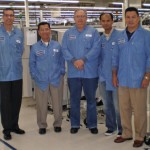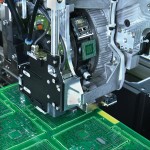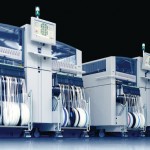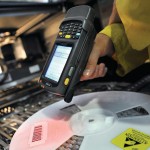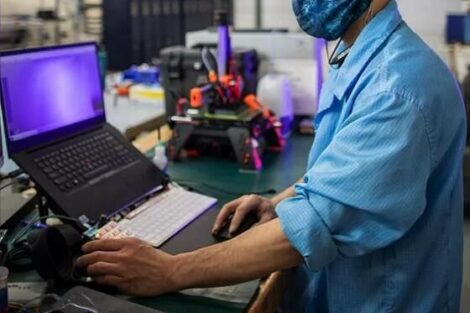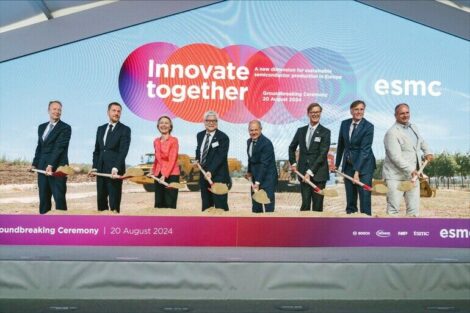Many of today’s most advanced mobile devices – from smartphones to tablets to popular consumer electronics – feature embedded Qualcomm technology. One of the company’s key advantages is the extreme speed in which it can transform chip and module designs into prototypes and volume production – thanks to solutions from Siplace.
ASM Assembly Systems, Munich (Germany)
If a company decides to convert its entire SMT production to a new equipment supplier in the space of only a few years, it must have good reasons for taking such a drastic step. Cam Nguyen, Senior Staff Manager of Engineering, at Qualcomm’s New Product Introduction (NPI) manufacturing facility in San Diego explains: “In 2007, we redefined our role as a production team. We had noticed that our equipment and our processes were forcing our develo-pers to ‘design to manufacture.’ As a result, they were constrained to design proto- types that we could physically build. We envisioned giving our R&D teams more freedom. We set a new goal for our team: enable engineering to design the most advanced products possible.”
New placement technologies
In 2007, the company’s NPI manufacturing operated four SMT lines with placement machines from various manufacturers in three shifts. After conducting a careful evaluation and making the decision to keep production in-house, Cam and his team selected Siplace as their new technology partner.
After introducing the first line with three Siplace X2 machines in 2008, the company was able to improve its manufacturing capacity to such an extent that one of the three shifts could be eliminated. Another line with three X2 machines followed in 2009. Marc Hrossowyc, Staff Engineer Qualcomm NPI, lists the new capabilities provided by this line: “For the first time we were able to offer our developers reliable 01005 and package-on-package (PoP) processes, which opened up an entirely new set of possibilities for them.”
In 2011, the NPI manufacturing team completed the latest step of its modernization program, investing in another X2 and re-arranging the machines into three SMT lines. They also installed new Siplace MultiStar heads on the two-machine lines as well as the line with three X2.
The MultiStar’s ability to switch between various placement modes – pick & place, collect & place and mixed mode – provides the manufacturing team with a completely new degree of flexibility. “Instead of being the bottleneck in the development process, we can now offer technologies such as 01005, PoP and flip chip before our developers have even asked for it,” says Cam. “Another important factor is that by manufacturing in-house we kept our costs lower than we would have if we had worked with external service providers.”
Flexible setup processes make the difference
At the same time, the NPI manufacturing introduced new setup concepts in order to be able to manage the frequent changeovers required for efficient and reliable prototype manufacturing. The company organized all steps in the setup changeover process in a rotary flow. At the kitting stations next to the SMT lines, workers match components for upcoming products with the corresponding intelligent X feeders. A conveyor transports the feeders and component reels to the set-up area, where they are loaded onto changeover tables using the Setup Center software for offline verification. The completed and verified feeder tables are then moved to a staging area, from where they are docked to the line when the time for the actual setup changeover has come. Feeder tables which are no longer needed are moved to the tear-down area, where employees remove and return the components to storage and place the X feeders back in special racks, ready for the next setup.
Kevin Nguyen, another member of the NPI manufacturing team, explains the benefits: “The rotary flow principle with Siplace hardware and software allows us to easily manage up to 80 setup changeovers per week – almost four times as many as before, and we are doing it with fewer shifts. We can even insert prototypes as one-offs into the production flow, and return them to the developers the same day. Compared to the one to two weeks needed if we worked with outside manufacturers, this is a critical speed gain in the development process.”
Re-balling and interposer
The NPI manufacturing team also introduced several new special processes using Siplace equipment. The team is now using the accuracy of these machines to re-ball BGAs by placing the balls out of tape and reel and then running the device through reflow. This is giving a first pass yield (FPY) of the repaired device of 90% compared to a 50% FPY using conventional repair technologies, due to the fact that heat can be ramped much more smoothly in the reflow process. “The re-balling process is a huge advantage to us when we have a shortage of a particular component,” says Kevin.
The NPI manufacturing also used the PoP capabilities of the X machines to speed up its development process. To test new chip generations which were not pin-compatible with existing designs, the design team previously had to wait for the new design of the PCB. Today, the company handles its rapid prototyping with interposers, which adapt the pin-out of the new chip design to the existing PCB as an additional layer in the PoP placement process. Instead of having to wait two to four weeks for the new board, the interposer and the PoP process make it possible to test the chip design on a prototype in less than one week.
Progress never stops
Cam Nguyen and his team always try to stay a step ahead of their own development department. After flip-chips, PoP and 0.4 mm pitches, they are currently testing and introducing innovative processes such as package-on-glass or 0.3 mm pitches. “The cooperation with the Siplace team and the deployment of their state-of-the-art, highly flexible placement solutions have enabled our production team to shorten the development and production times for our newest products and to generate critical competitive advantages for the introduction of new technologies,” summarizes Cam.
SMT Hybrid Packaging
Booth 7-204
Zusammenfassung
Der Artikel befasst sich mit der erfolgreichen Umorganisation des Produktionsumfelds bei Qualcomm. Hier wird aufgezeigt, wie anhand innovativem Equipment der NPI-Prozess schnell und zuverlässig vonstatten geht.
L’article s’intéresse aux changement d’organi- sation réussi en matière d’environnement de production chez Qualcomm. On indique ici comment au moyen d’un équipement innovant, le processus NPI a évolué de manière rapide et fiable.
About Qualcomm
Qualcomm is the world leader in 3G and next-generation mobile technologies. For more than 25 years, Qualcomm ideas and inventions have driven the evolution of wireless communications, connecting people more closely to information, entertainment and each another. Today, Qualcomm technologies are powering the convergence of mobile communications and consumer electronics, making wireless devices and services more personal, affordable and accessible to people everywhere.
Share:




